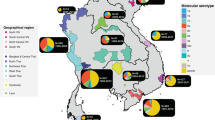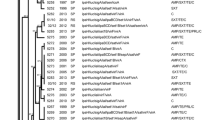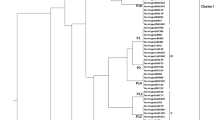Abstract
Shigellosis is a highly infectious disease that is mainly transmitted via fecal-oral contact of the bacteria Shigella. Four species have been identified in Shigella genus, among which Shigella flexneri is used to be the most prevalent species globally and commonly isolated from developing countries. However, it is being replaced by Shigella sonnei that is currently the main causative agent for dysentery pandemic in many emerging industrialized countries such as Asia and the Middle East. For a better understanding of S. sonnei virulence and antibiotic resistance, we sequenced 12 clinical S. sonnei strains with varied antibiotic-resistance profiles collected from four cities in Jiangsu Province, China. Phylogenomic analysis clustered antibiotic-sensitive and resistant S. sonnei into two distinct groups while pan-genome analysis reveals the presence and absence of unique genes in each group. Screening of 31 classes of virulence factors found out that type 2 secretion system is doubled in resistant strains. Further principle component analysis based on the interactions between virulence and resistance indicated that abundant virulence factors are associated with higher levels of antibiotic resistance. The result present here is based on statistical analysis of a small sample size and serves basically as a guidance for further experimental and theoretical studies.



Similar content being viewed by others
Data availability
All data generated or analyzed during this study are included in this published article and its supplementary information files.
References
Alikhan NF, Petty NK, Ben Zakour NL, Beatson SA (2011) BLAST Ring Image Generator (BRIG): simple prokaryote genome comparisons. BMC Genomics 12:402
Andersson DI, Hughes D (2010) Antibiotic resistance and its cost: is it possible to reverse resistance? Nat Rev Microbiol 8:260–271
Bankevich A, Nurk S, Antipov D, Gurevich A, Dvorkin M, Kulikov A, Lesin V, Nikolenko S, Pham S, Prjibelski A, Pyshkin A, Sirotkin A, Vyahhi N, Tesler G, Alekseyev M, Pevzner P (2012) SPAdes: a new genome assembly algorithm and its applications to single-cell sequencing. J Comput Biol 19:455–477
Cameron DR, Mortin LI, Rubio A, Mylonakis E, Moellering RC, Eliopoulos GM, Peleg AY (2015) Impact of daptomycin resistance on Staphylococcus aureus virulence. Virulence 6:127–131
Chen L, Yang J, Yu J, Yao Z, Sun L, Shen Y, Jin (2004) VFDB: a reference database for bacterial virulence factors. Nucleic Acids Res 33:325–328
Darling ACE (2004) Mauve: multiple alignment of conserved genomic sequence with rearrangements. Genome Res 14:1394–1403
Edwards DJ, Holt KE (2013) Beginner’s guide to comparative bacterial genome analysis using next-generation sequence data. Microb Informatics Exp 3:2
Geisinger E, Isberg RR (2017) Interplay between antibiotic resistance and virulence during disease promoted by multidrug-resistant bacteria. J Infect Dis 215:S9–S17
Guillard T, Pons S, Roux D, Pier G, Skurnik D (2016) Antibiotic resistance and virulence: understanding the link and its consequences for prophylaxis and therapy. BioEssays 38:682–693
Johnson LS, Eddy SR, Portugaly E (2010) Hidden Markov model speed heuristic and iterative HMM search procedure. BMC Bioinformatics 11:431
Kozyreva VK, Jospin G, Greninger AL, Watt JP, Eisen JA, Chaturvedi V (2016) Recent outbreaks of Shigellosis in California caused by two distinct populations of Shigella sonnei with either increased virulence or fluoroquinolone resistance. mSphere 1:e00344–e00316
Letunic I, Bork P (2016) Interactive tree of life (iTOL) v3: an online tool for the display and annotation of phylogenetic and other trees. Nucleic Acids Res 44:242–245
Niyogi SK (2005) Shigellosis. J Microbiol 43(2):133–143
Page AJ, Cummins CA, Hunt M, Wong VK, Reuter S, Holden MT, Fookes M, Falush D, Keane JA, Parkhill J (2015) Roary: rapid large-scale prokaryote pan genome analysis. Bioinformatics 31:3691–3693
Pizarro-Cerdá J, Cossart P (2006) Bacterial adhesion and entry into host cells. Cell 124:715–727
Price MN, Dehal PS, Arkin AP (2009) FastTree: computing large minimum evolution trees with profiles instead of a distance matrix. Mol Biol Evol 26:1641–1650
Seemann T (2014) Prokka: rapid prokaryotic genome annotation. Bioinformatics 30:2068–2069
Thompson CN, Duy PT, Baker S (2015) The rising dominance of Shigella sonnei: an intercontinental shift in the etiology of bacillary dysentery. PLoS Negl Trop Dis 9:e0003708
Watson J, Jenkins C, Clements A (2018) Shigella sonnei does not use amoebae as protective hosts. Appl Environ Microbiol 84:e02679–e02617
Yang F (2005) Genome dynamics and diversity of Shigella species, the etiologic agents of bacillary dysentery. Nucleic Acids Res 33:6445–6458
Zhang L, Levy K, Trueba G, Cevallos W, Trostle J, Foxman B, Marrs CF, Eisenberg JN (2015) Effects of selection pressure and genetic association on the relationship between antibiotic resistance and virulence in Escherichia coli. Antimicrob Agents Chemother 59:6733–6740
Funding
This work was supported by the National Natural Science Foundation of China (81902040, 81871734, 81701390, 81471994, 31900022), Natural Science Foundation of Jiangsu Province (BK20170250, BK20180997), Jiangsu Provincial Medical Talent (ZDRCA2016053), Six Talent Peaks Project of Jiangsu Province (WSN-135), Advanced Health Talent of Six-One Project of Jiangsu Province (LGY2016042), Jiangsu Provincial Commission of Health and Family Planning Research Project (H201631), Open Project from the Jiangsu Key Laboratory of New Drug Research and Clinical Pharmacy (No. KFXY201905), Xuzhou Science and Technology Innovation Project (KC19057), Young Science and Technology Innovation Team of Xuzhou Medical University (2020), and Jiangsu Qinglan Project (2020).
Author information
Authors and Affiliations
Contributions
BG, ZZ, and LW conceived the core ideas and wrote the manuscript. LW did data analysis and visualization. HQ, FG, YL, HZ, and YC did sample collection, bacterial culture, and genome sequencing. JS, PM, and CB revised the manuscript critically. BG, ZZ, and LW provided platforms and resources. All the authors approved the publication of the manuscript.
Corresponding author
Ethics declarations
Conflict of interest
The authors declare that they have no conflict of interest.
Ethics statement and approval
The study was performed in accordance with the ethical standards as laid down in the 1964 Declaration of Helsinki and its later amendments or comparable ethical standards. This study was approved by the Ethics Committee of Affiliated Hospital of Xuzhou Medical University (XYFY2015 JS005-01).
Informed consent
All study participants were above the legal age of consent at the time of participation, and written informed consent was obtained from all volunteers prior to participation in the study. Sincere thanks to the participants of this study for their time and involvement.
Consent for publication
Not available.
Additional information
Publisher’s note
Springer Nature remains neutral with regard to jurisdictional claims in published maps and institutional affiliations.
The manuscript is available online in BioRxiv as a preprint https://doi.org/10.1101/544387.
Electronic supplementary material
Supplementary Figure 1
Pan-genome analysis of 12 clinically isolated Shigella sonnei strains with different antibiotic resistant profiles. (DOCX 43 kb)
Supplementary Table 1
Distribution patterns of 4 categories of virulence factors that belong to 31 groups among 12 Shigella sonnei strains in terms of antibiotic resistance (DOCX 21 kb)
Supplementary Table 2
The complete list of gene absence and presence among the 12 Shigella sonnei strains. (XLSX 872 kb)
Rights and permissions
About this article
Cite this article
Zhu, Z., Wang, L., Qian, H. et al. Comparative genome analysis of 12 Shigella sonnei strains: virulence, resistance, and their interactions. Int Microbiol 24, 83–91 (2021). https://doi.org/10.1007/s10123-020-00145-x
Received:
Revised:
Accepted:
Published:
Issue Date:
DOI: https://doi.org/10.1007/s10123-020-00145-x




